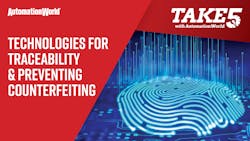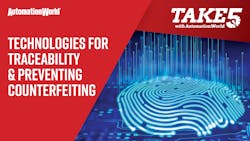Quick hits:
- FDA’s New Era of Smarter Food Safety Blueprint addresses new food delivery business models.
- Blockchain key to stricter record-keeping requirements.
- Alitheon’s optical artificial intelligence system can authenticate products by simply taking a picture.
Welcome to Take Five. I’m Stephanie Neil and today we’re looking at technologies that will help with traceability and product authenticity.
While the industry has been overwhelmed by supply chain issues and skyrocketing prices, we tend to forget that there are still important regulatory mandates that many manufacturers in the food and beverage and pharmaceutical industries need to comply with.
For example, this past October, the Food and Drug Administration held a three-day summit to better understand how foods are sold through business to consumer e-commerce models and the standards of care used by industry to control the safety risks of food sold online.
This followed the introduction of the FDA’s New Era of Smarter Food Safety Blueprint, which was first introduced in 2020, and identifies future paths of action needed to address new business models of food delivery.
The blueprint is centered around four core elements:
- Tech-enabled traceability
- Smarter tools and approaches for prevention and outbreak response
- New business models and retail modernization
- And food safety culture
Tech-enabled traceability is the first step in the FDA’s work, which includes harmonizing the key data elements and critical tracking events to provide end-to-end traceability.
And the technology to do that is blockchain.
A reminder of what blockchain is—it is the technology that underpins cryptocurrencies and other applications by providing a secure, decentralized approach to distributing digital information in a way that can be shared but not modified. The FDA is encouraging more use of blockchain to help pinpoint the exact sources of foods involved in an outbreak.
It sounds like a great plan, but it will be up to the manufacturers to figure out how to implement a tracking system that includes last mile delivery to the consumer, and these companies already have a whole lot on their plate right now.
Fortunately, there are other technologies surfacing that can help. I’ll tell you about one in particular that can even keep counterfeit goods out of the supply chain.
In addition to food safety, combatting counterfeit goods is another area of concern for manufacturers. The traditional approach to this has been barcodes, tags, and special labels. The problem is these things can be removed, get damaged, or be counterfeit themselves.
But a startup company called Alitheon has come up with a way to solve this problem using optical artificial intelligence. Much like a fingerprint, which is very unique, the optical AI identifies physically inherent characteristics of goods. Because, even if they appear identical, they are not.
The Alitheon algorithm captures a one-of-a-kind “FeaturePrint” which can identify minuscule differences in the surface of an item. That image is stored in a system to create a digital baseline for future reference. So the end user on the receiving end can simply take a picture of the item using their mobile phone and the Alitheon app will know right away if the product is authentic or has been tampered with during its travels.
There are many potential ways to use this technology. For example, this could solve recall problems. In the automotive industry, a recall requires all cars in question be brought back to the shop to be checked. Instead, a simple picture of the part would tell the mechanic when it was manufactured, saving a lot of time and money.
That’s all we have time for today, thank you for joining me on this edition of Take Five, I’ll see you next time.
Leaders relevant to this content:





